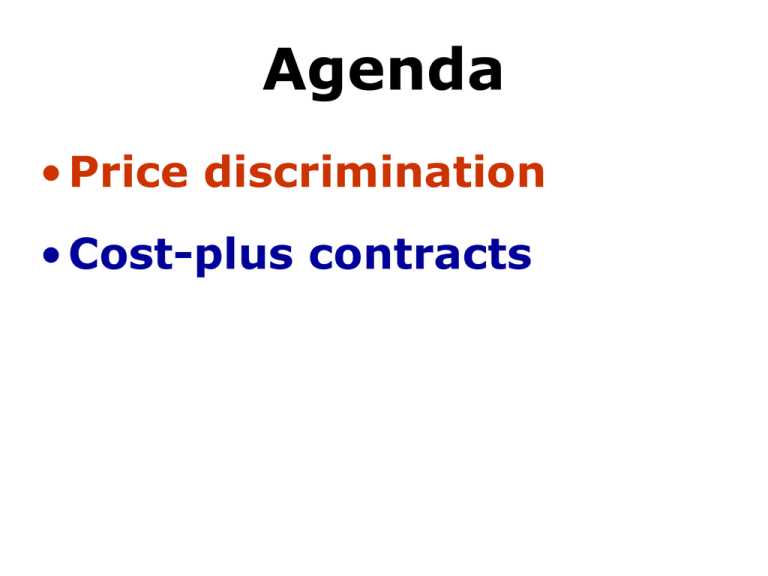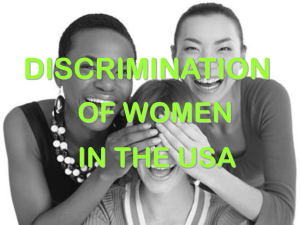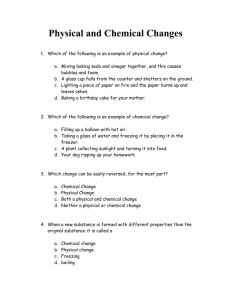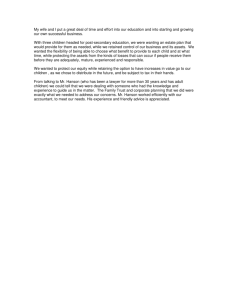Incremental Analysis
advertisement

Agenda • Price discrimination • Cost-plus contracts Price Discrimination Antitrust: Consisting of laws to protect trade and commerce from unlawful restraints and monopolies or unfair business practices. Sited from Merriam-Webster Price Discrimination • Sherman Act of 1890 – Illegal to monopolize trade – Illegal to conspire in restraint of trade – Prohibits predatory pricing • Clayton Act of 1914 – Elaborated on the Sherman Act – Forbids price discrimination in favor of big buyers – Forbids purchasing stock in a competitor Price Discrimination • Robinson-Patman Act of 1936 –Amended the Clayton Act –Administered by the U.S. Federal Trade Commission –Fundamental principal of the act: •“To assure, to the extent reasonably practicable, that businessmen at the same functional level would stand on equal competitive footing so far as price is concerned.” Price Discrimination • Robinson-Patman Act of 1936 – Identified three possible defenses against charges of price discrimination: • Differences in prices arising from differences in manufacturing costs • Quantity purchases from customers • The need to meet competitors’ prices – As originally drafted, the Act applied to “commodities,” and this still appears to be the case. In other words, goods, not services. Price Discrimination • Hanson Paint and Glass Co. vs. Pittsburg Plate Glass Industries, 1973 • William Inglis and Sons Baking Co. vs. ITT Continental Baking Company Inc., 1981 • Brooke Group Ltd. vs. Brown & Williamson Tobacco Corp., 1993 Price Discrimination Hanson Paint and Glass Co. vs. Pittsburg Plate Glass Industries, 1973 Hanson, an old employee of Pittsburgh glass company, opened his own store. He bought supplies from Pittsburgh and other companies at low prices, but continued to operate at a loss. Pittsburgh sold to Hanson’s competitor at a lower price. Hanson accused PPG of violating the RobinsonPatman Act. Price Discrimination Hanson Paint and Glass Co. vs. Pittsburg Plate Glass Industries, 1973 Recall the three possible defenses: • Differences in prices arising from differences in manufacturing costs • Quantity purchases from customers • The need to meet competitors’ prices Price Discrimination Hanson Paint and Glass Co. vs. Pittsburg Plate Glass Industries, 1973 1) Price differences as a result of different manufacturing techniques. PPG proved that Hanson bought a different cut of glass than his competitor, Martex. Price Discrimination Hanson Paint and Glass Co. vs. Pittsburg Plate Glass Industries, 1973 2) Different prices due to different quantities purchased. PPG showed that Hanson bought 41 sq. ft. compared to Magnolia, another competitor, buying 429 sq. ft. Price Discrimination Hanson Paint and Glass Co. vs. Pittsburg Plate Glass Industries, 1973 3) Attempt to Meet Competition PPG offered Martex a higher discount because PPG had been turned down once before due to Martex finding a better price at Safelite. Hence: PPG won this case by using all three defenses identified in the Robinson-Patman Act Price Discrimination William Inglis and Sons Baking Co. vs. ITT Continental Baking Company Inc., 1981 Both companies sold bread under a brand name label and a generic label. Name Label: Available nationally at all stores: Inglis - Sunbeam Continental - Wonder Bread Generic label sold at a price below the advertised name label. Price Discrimination William Inglis and Sons Baking Co. vs. ITT Continental Baking Company Inc., 1981 Continental’s selling price went from 19 to 18 cents; two years later went to 17.2 cents. Inglis charged that, “The low prices on private label bread were subsidized by prices on brand name bread.” Price Discrimination William Inglis and Sons Baking Co. vs. ITT Continental Baking Company Inc., 1981 • Inglis claimed that Continental: – Sold bread below cost (average variable cost) during the 1970s – Forced Inglis out of business because of a “monopoly” – Charged different prices in Nevada than in California – Violated the Robinson-Patman Act • The jury granted Inglis $5 million Price Discrimination William Inglis and Sons Baking Co. vs. ITT Continental Baking Company Inc., 1981 • The judge threw out the verdict. • Inglis appealed the ruling. • The judge and the Appeals Court – Defined “attempt to monopolize” – Determined when prices are predatory – Determined when companies can reduce prices to meet competition Price Discrimination William Inglis and Sons Baking Co. vs. ITT Continental Baking Company Inc., 1981 • Inglis used variable costing to prove Continental set prices lower than cost – Included all costs as variable except plant depreciation, taxes, and business license fees – Determined cost and selling price as: •Cost: $0.206 •Selling Price: $0.172 Price Discrimination William Inglis and Sons Baking Co. vs. ITT Continental Baking Company Inc., 1981 • Judge Williams and the Appeals Court determined that – marginal costing should be used: Look at the change in sales price relative to the change in variable costs – many costs claimed by Inglis to be variable were really short-run fixed costs. • Inglis was forced to drop the case Predatory Pricing Brooke Group Ltd. vs. Brown & Williamson Tobacco Corp., 1993 • The U.S. Supreme Court defined predatory pricing as – A situation in which a company has set prices below average variable cost and planned to raise prices later to recover the losses from lower prices. • Relevant for both short-term and longterm pricing decisions. Predatory Pricing Brooke Group Ltd. vs. Brown & Williamson Tobacco Corp., 1993 • The U.S. Supreme Court used economic theory to conclude that predatory pricing does not work, and ruled in favor of B&W. • The Court determined that “Congress did not intend to outlaw price differences that result from or further the forces of competition.” Predatory Pricing Brooke Group Ltd. vs. Brown & Williamson Tobacco Corp., 1993 • In the subsequent 37 predatory pricing cases after this case, the defendants prevailed. • In 2001, a Federal judge threw out a lawsuit against American Airlines alleging predatory pricing in the Dallas-Fort Worth market. Predatory Pricing • Predatory pricing also applies to antidumping laws in international trade. • U.S. anti-dumping laws stipulate that the import price cannot be lower than the cost of production. • The World Trade Organization found that the number of cases brought under antidumping laws increased 35% from 1995 to 2000. Agenda • Price discrimination • Cost-plus contracts Cost-Plus Contracts • Where are these contracts found: –Defense contractors –University research –The entertainment industry • Why are these contracts used: –To share risk more efficiently Cost-Plus Contracts • Where are these contracts found: –Defense contractors –University research –The entertainment industry • Why are these contracts used: –To share risk more efficiently Defense Contractors • In the first presidential debate, John McCain called for eliminating costplus contracts in the defense industry. He urged for all contracts to be written as fixed cost contracts. Defense Contractors • Common Types of Fraud in Defense Contracts – Cross-Charging – Improper Cost Allocation – Inflating Costs Cross Charging • One of the most common types of defense contractor fraud • May occur when a company has a “fixed price contract” and a “cost-plus contract” – Fixed Price Contract: The company receives a fixed price for a certain number of goods regardless of the cost of production. – Cost-Plus Contract: The company is reimbursed for the cost of production, plus a percentage of its costs as a profit. Cross Charging • The company has an incentive to charge time that it spends working on the fixedprice contract to the cost-plus contract. Cross Charging The United States vs. Jana, Inc. • Jana, Inc. was a defense contractor for the United States government. – Jana had several different contracts with the United States. – One of the contracts was a fixed-price contract with the U.S. Army – Another contract was a cost-reimbursement time and materials contract with the U.S. Navy. Cross Charging The United States vs. Jana, Inc. • Jana assigned similar charge codes to the two contracts. • While work was being done, employees accurately identified time spent on each project on their time cards. • Jana would later go back and change one number in the charge code so that work being done on the fixed-price contract would be billed to the cost-plus contract with the Navy. Cross Charging The United States vs. Jana, Inc. • An employee of Jana obtained an altered time card and notified the Department of Justice. • The Department of Justice randomly sampled time cards related to the two contracts and found numerous alterations Improper Cost Allocation • Improper cost allocation is similar to cross-charging. • In this case the contractor normally has both commercial business contracts and defense contracts. • The contractor is supposed to allocate overhead costs among the various contracts based on actual costs incurred. Improper Cost Allocation • Overhead costs should be allocated on the basis of square footage, direct labor charges, or other meaningful cost drivers. • The contractor has an incentive to improperly shift overhead from the commercial contracts to the government contracts. Inflating Costs • Inflating costs during negotiations with the government to get a higher price for a sole-source contract violates the law. • The government requires that all contractors reveal all relevant information about costs to the government in solesource contracts. Inflating Costs • Some companies inflate their cost estimates by including “pads.” • The inflated costs are sometimes referred to as management reserves or negotiation losses. • These costs could be legitimate cost items but they must be fully disclosed and cannot be buried in other cost estimates. Inflating Costs The United States vs. FMC Corp. • FMC was a diversified manufacturing company that made the Bradley Fighting Vehicle from 1991 to 1994. • The government paid FMC $1.1 billion. Inflating Costs The United States vs. FMC Corp. • In 1995 a mid-level manager from FMC filed a lawsuit against FMC for defrauding the government. • FMC had budgeted far less for research and development than what they had quoted. • When the employee informed senior company officials, they refused to allow the employee to disclose the company’s internal budget. Inflating Costs The United States vs. FMC Corp. • As a result of the lawsuit, FMC had to pay the government $13 million to settle the case. • The employee received $2.86 million for reporting the fraud. Cost-Plus Contracts • Where are these contracts found: –Defense contractors –University research –The entertainment industry • Why are these contracts used: –To share risk more efficiently University Research Scandal in the Laboratories • How does the government determine cost reimbursement rates for Federallysponsored research? • The Facilities & Administrative Cost Rate: – Federal agency negotiators and university administrators agree on an overall percentage – Based on documented historical costs and cost analysis studies – Negotiated every three years University Research Scandal in the Laboratories • The reimbursement rates vary from institution to institution. – Construction, maintenance, utilities and administrative costs vary by institution and region University Research Scandal in the Laboratories • In 1990, Paul Biddle filed a lawsuit against Stanford University • Claimed Stanford was overcharging taxpayers for research related expenses – Creative bookkeeping practices used to charge the government for: • Depreciation on a 72 ft. yacht • Faculty discounts on tickets to athletic events • A percentage of the cost of flowers, bedsheets, tablecloths and antiques for the president’s house University Research Scandal in the Laboratories • Stanford’s Overhead rate – 74%, among highest in the country – In part because Stanford was very aggressive about recovering every nickel – University President Donald Kennedy said “I expect our controllers to do their best on behalf of the university.” – Some argue that the school was overly zealous in its quest for money. University Research Scandal in the Laboratories • Schools differ in the items they include in overhead: – Columbia, Harvard, M.I.T. and Cornell argue that the president’s residence is a part of “general administration” • They charge the government anywhere from 14% to 68% of the maintenance costs • Yale and John Hopkins consider the amount involved too small to bother inclusion • These charges are legal, unlike those for Stanford’s yacht, but difficult to defend University Research Scandal in the Laboratories • Federal Audit Process – The government is supposed to audit the institution every two to three years • In Stanford’s case, claims and receipts were not checked from 1983 through 1988 • Government Budget Cuts – Less willing to help universities expand or update their scientific infrastructure University Research Scandal in the Laboratories • March, 1991 – Congress held hearings on Stanford. • July, 1991 – President Donald Kennedy resigned • August, 1992 – The General Accounting Office issued a study of Stanford and three other universities • Found over-billing of a total of $29 Million by all four universities, far less than claimed by Biddle University Research Scandal in the Laboratories • 1993 – The Justice Department announced that it would not intervene as a plaintiff in the Biddle case • 1994 – The Office of Naval Research announced that it would drop all charges of wrongdoing against Stanford • Stanford repaid the government $2.2 million for all unresolved claims from 1981 through 1992, and received $700 million during that same time period. Cost-Plus Contracts • Where are these contracts found: –Defense contractors –University research –The entertainment industry • Why are these contracts used: –To share risk more efficiently The Entertainment Industry The Problem • Creators, actors and actresses sign contracts that provide them a percentage of the profits that are generated from their films and television shows. • Production studios are creating their own definition of net profits that guarantees that profit participants rarely receive their cut. The Entertainment Industry • The 1989 movie Coming to America grossed $240 million, of which Paramount received $122 million. • The net profit participants were told the film had a net loss of nearly $16 million. • Questionable accounting practices by the production studios: – Double charging – Cost shifting – Questionable allocation methods for general overhead The Entertainment Industry Coming to America • • • • • Gross income Distribution Fee Distribution Expenses Production Costs Interest Expense • Net Profit (Loss) $122 million $ 40 million $ 34 million $ 58 million $ 6 million --------------($ 16 million) --------------- The Entertainment Industry • Other individuals from the entertainment industry who have been “burned.” –James Garner •The Rockford Files –Stan Lee (creator of Spider-man) •Contracted with Marvel for 10% of the profits. •The film grossed more than $400 million. •Stan Lee “never saw a penny.” •The studio reported millions of dollars in “earnings,” but no “profits” as defined by their contract with Lee.







